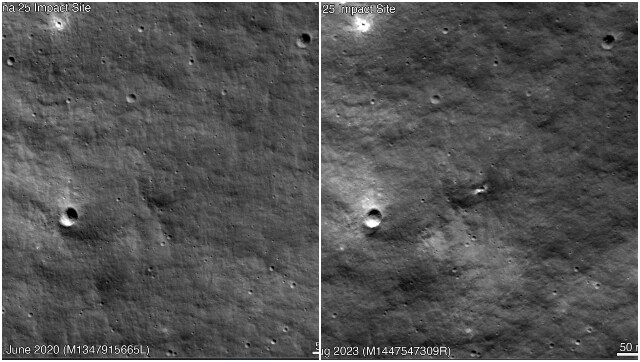NASA’s Lunar Reconnaissance Orbiter (LRO) has captured images of a newly formed crater on the Moon’s surface, believed to be the result of Russia’s Luna 25 mission.
Luna 25, a Russian lunar lander, encountered an anomaly during its descent, causing it to crash on the Moon’s surface on August 19th. The LRO spacecraft’s images provide valuable insight into the impact site and the aftermath of the Luna 25 mission’s landing failure.
Official reports have suggested that the Luna 25 lander module crashed after one of the thrusters on board the Luna 25 went out of control, and crashed on the moon.
The Lunar Reconnaissance Orbiter (LRO) captured images of a new crater on the Moon’s surface, likely resulting from Russia’s Luna 25 mission. The latest “before” image of the area was taken in June 2022, meaning the crater formed after that date.

The proximity of the crater to the estimated impact point of Luna 25 suggests that it was caused by the failed mission rather than a natural event.
The LRO spacecraft, managed by NASA’s Goddard Space Flight Center, has provided valuable data since its launch in 2009. Its images and observations have significantly contributed to our understanding of the Moon’s surface and geological features.
The Lunar Reconnaissance Orbiter Camera (LROC), operated by Arizona State University, captured the images of the Luna 25 impact site.
The newly formed crater has a diameter of approximately 10 meters and is situated at coordinates 57.865 degrees south latitude and 61.360 degrees east longitude, at an elevation of around minus 360 meters.
The impact occurred on the steep inner rim of the Pontécoulant G crater, with a grade greater than 20 degrees. This impact site is located about 400 kilometres away from Luna 25’s intended landing point, which was at 69.545 degrees south and 43.544 degrees east.
from Firstpost Tech Latest News https://ift.tt/wLV5vz9

No comments:
Post a Comment
please do not enter any spam link in the comment box.